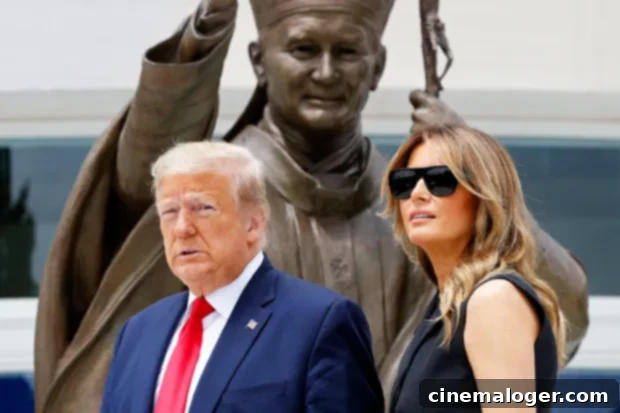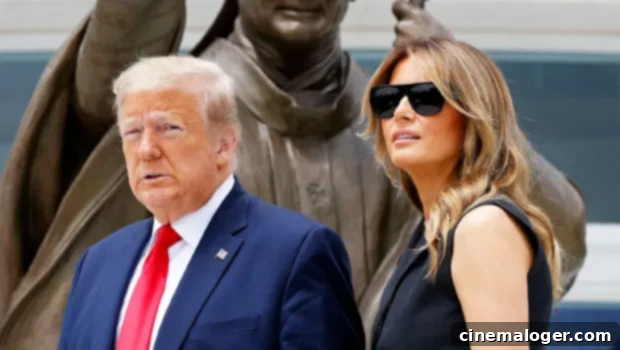Melania Trump’s Shrine Visit: The ‘Smile’ Moment Amidst National Turmoil and Religious Condemnation
In early June 2020, as the United States grappled with widespread protests against racial injustice and police brutality sparked by the tragic death of George Floyd, President Donald Trump and First Lady Melania Trump made several highly scrutinized public appearances. One such event, a visit to the Saint John Paul II National Shrine in Washington D.C. on June 2, drew particular attention not only for the ensuing controversy with religious leaders but also for a subtle yet widely observed interaction between the presidential couple. During a photo opportunity at the shrine, Donald Trump, then 73, was seen appearing to instruct First Lady Melania Trump, 50, to smile, a moment that quickly ignited discussions across social media and media outlets, highlighting the intense public scrutiny under which the First Family operated during a period of national upheaval. This seemingly minor gesture became emblematic of broader questions regarding public image, personal expression, and the political pressures faced by those in power during times of profound social unrest, coming just one day after another contentious visit to St. John’s Episcopal Church following his speech about the nationwide protests against criminal injustice.
The incident unfolded at the Saint John Paul II National Shrine, a Catholic facility, during a formal photo session. As President Trump posed, offering a broad smile to the cameras, First Lady Melania Trump maintained a notably serious and composed expression. Video footage from the event captured the President subtly leaning towards his wife and appearing to utter a brief instruction. Almost immediately after his words, Mrs. Trump’s demeanor shifted, and she quickly offered a smile, which she then held for the remainder of the photo op. This fleeting but impactful exchange resonated deeply with observers, especially given the preceding day’s contentious events and the somber national mood. The juxtaposition of President Trump’s seemingly jovial disposition with the First Lady’s initially reserved expression, followed by her rapid compliance, fueled a wave of commentary online and across news platforms. Many viewed it as a revealing glimpse into the dynamics of their public appearances, suggesting a perceived expectation for the First Lady to project a particular image, regardless of the underlying context or her personal sentiments.
Trump asks Melania to smile during today’s photo op. pic.twitter.com/B59YeDHKRM
— The Recount (@therecount) June 2, 2020
This particular moment, though brief, quickly became a focal point for public discussion, amplified by its rapid dissemination across social media platforms. It wasn’t an isolated incident; indeed, First Lady Melania Trump’s facial expressions and overall demeanor during public engagements with her husband had frequently captured media attention and sparked speculation throughout his presidency. From instances where she appeared to visibly recoil from his hand during public greetings to various moments where her smile seemed forced or absent, these clips often went viral, leading to widespread “Free Melania” memes and amateur psychological analyses. The public’s fascination stemmed from a desire to understand the personal dynamics within the First Family, particularly given the often tumultuous political landscape. In the context of the shrine visit, social media users were quick to question the apparent dissonance between the President’s cheerful disposition and the First Lady’s initial solemnity. Commentators debated the reasons behind her serious face and speculated on the nature of the President’s instruction, interpreting it as anything from a simple marital nudge to a directive reflecting the curated nature of political appearances. This episode underscored the unique position of the First Lady and how her non-verbal cues could be interpreted as significant political or personal statements.

(REX/Shutterstock)
Beyond the personal dynamics observed during the photo op, President Trump’s visit to the Saint John Paul II National Shrine provoked strong condemnation from prominent religious leaders, signaling a deepening rift between the administration and various faith communities. Archbishop Wilton Gregory, the highest-ranking African-American bishop in the United States and head of the Archdiocese of Washington, issued a scathing statement shortly after the visit, expressing profound anger and disappointment. Archbishop Gregory declared the visit “baffling and reprehensible,” criticizing the shrine for allowing itself to be “egregiously misused and manipulated.” He emphasized that such an action profoundly violated the core religious principles of the Catholic faith, which inherently compel its followers to “defend the rights of all people, even those with whom we might disagree.” This strong rebuke highlighted concerns that the sacred space was being instrumentalized for political purposes, particularly during a period of intense civil unrest where the President’s rhetoric had been widely perceived as divisive and unconciliatory. The Archbishop’s statement resonated powerfully, not only within Catholic circles but also across the broader religious and political spectrum, as it challenged the administration’s approach to the ongoing national crisis and its respect for religious autonomy.
The condemnation from Archbishop Gregory was not an isolated incident but rather the second significant public rebuke from a religious official within 24 hours, underscoring a pattern of contentious interactions between the Trump administration and faith communities. Just one day prior to the shrine visit, on June 1, President Trump had engaged in another highly controversial photo opportunity at St. John’s Episcopal Church, colloquially known as “the Church of the Presidents,” directly across from the White House. This visit followed a speech in which he adopted a hardline stance against protesters. To facilitate his walk to the church, federal law enforcement officers employed tear gas and rubber bullets to forcibly clear peaceful demonstrators from Lafayette Square, sparking outrage across the nation and within the religious community. The Bishop of the Episcopal Diocese, Mariann Edgar Budde, whose diocese oversees St. John’s, expressed profound dismay and “outrage” over the President’s actions. In an interview with CNN’s Anderson Cooper, Bishop Budde asserted that President Trump had “used a bible and church of my diocese without permission as a backdrop for a message antithetical to the teachings of Jesus.” She condemned the clearing of protesters and the subsequent photo op as a cynical political stunt that desecrated a sacred space and directly contradicted the church’s values of peace, compassion, and justice for all. The forceful removal of citizens exercising their constitutional rights, merely to enable a presidential photo opportunity, intensified the criticisms of Trump’s leadership and his perceived disregard for civil liberties during a period of heightened sensitivity.
The President’s highly publicized visits to both St. John’s Episcopal Church and the Saint John Paul II National Shrine were set against a backdrop of unprecedented civil unrest following the tragic death of George Floyd, an African-American man, at the hands of Minneapolis police officers. Floyd’s death on May 25, 2020, sparked a wave of national and international protests demanding justice, police reform, and an end to systemic racial injustice. While many demonstrations were peaceful, some devolved into clashes, looting, and vandalism, which President Trump frequently highlighted. In response to the widespread protests, President Trump adopted a “law and order” approach, vehemently condemning what he labeled as “rioters” and “anarchists.” He delivered a speech threatening to invoke the Insurrection Act, which would allow him to deploy active-duty military personnel to states and cities if local and state leaders failed to quell the unrest to his satisfaction. These pronouncements were delivered amidst reports of federal police and National Guard troops using aggressive tactics against demonstrators, including the deployment of rubber bullets, tear gas, and pepper spray, resulting in thousands of injuries nationwide. The administration’s response to the protests, characterized by confrontational rhetoric and forceful police actions, further inflamed tensions and drew criticism for potentially escalating rather than de-escalating the fraught situation. The President’s strategic use of religious sites for photo opportunities during this volatile period was widely seen as an attempt to project strength and appeal to his conservative base, but it ultimately ignited a firestorm of condemnation from diverse segments of society, including prominent religious leaders who felt their institutions were being co-opted for political messaging contrary to their spiritual missions. The overall atmosphere was one of profound division, with the “smile” instruction to the First Lady becoming a small, yet telling, footnote in a much larger national narrative of crisis and contention.
